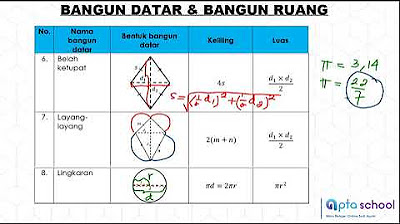BAB 2 BANGUN RUANG kelas 7 SMP #bangunruangsisidatar #bangunruangsisilengkung #volume #luaspermukaan
Summary
TLDRThis video introduces the concept of three-dimensional solid figures, or 'bangun ruang.' It covers the definitions, classifications, and formulas for various solid shapes, including those with flat and curved surfaces. Key topics include the positioning of lines (intersecting, parallel, etc.), types of solid figures like spheres, cones, and cubes, as well as their surface area and volume formulas. The video also discusses polyhedra, which are defined as 3D shapes bounded by flat surfaces. Practical exercises are provided to reinforce the learning of surface area and volume calculations.
Takeaways
- 😀 Definition of Solid Shapes: Solid shapes are three-dimensional objects with flat or curved surfaces.
- 😀 Positioning of Lines: There are four possible relationships between two lines—intersecting, overlapping, parallel, or crossing.
- 😀 Types of Solid Shapes: Solid shapes are categorized into those with curved surfaces (sphere, cylinder, cone) and those with flat surfaces (cube, rectangular prism, pyramid, prism).
- 😀 Surface Area and Volume Formulas: Formulas for calculating surface area and volume vary for solids with curved surfaces and those with flat surfaces.
- 😀 Polyhedron: A polyhedron is a solid shape with flat faces.
- 😀 Differences Between Solid Shapes: The key differences among solid shapes lie in the type of surfaces they have (curved or flat).
- 😀 Polyhedron Characteristics: Polyhedrons are solid shapes bounded by flat surfaces called faces.
- 😀 Example Problem: The video includes an example of finding the volume and surface area of a pyramid.
- 😀 Importance of Geometry: Understanding solid shapes is crucial for solving real-world problems in various fields like architecture and engineering.
- 😀 Interactive Learning: The lesson encourages viewers to engage by practicing problems and subscribing for more content.
Q & A
What is the definition of a solid shape (bangun ruang)?
-A solid shape, or 'bangun ruang' in Indonesian, is a three-dimensional figure with flat and curved surfaces.
How are lines classified based on their position to each other?
-Lines are classified into four categories based on their position: crossing, coincident, intersecting, and parallel.
What are the two main categories of solid shapes?
-Solid shapes are categorized into two main types: those with curved surfaces (like spheres, cylinders, and cones) and those with flat surfaces (like cubes, cuboids, pyramids, and prisms).
Can you give examples of solid shapes with curved surfaces?
-Examples of solid shapes with curved surfaces include spheres, cylinders, and cones.
What are examples of solid shapes with flat surfaces?
-Examples of solid shapes with flat surfaces include cubes, cuboids, pyramids, and prisms.
What formulas are discussed in the chapter for solid shapes?
-The chapter discusses formulas for calculating the surface area and volume of both curved and flat-surfaced solid shapes.
What is the main focus of the discussion on polyhedra?
-Polyhedra are solid shapes that are bounded by flat planes, and the chapter explains their characteristics.
What is the difference between solid shapes with curved surfaces and those with flat surfaces?
-Solid shapes with curved surfaces, like spheres and cones, have smooth, continuous surfaces, whereas solid shapes with flat surfaces, like cubes and pyramids, are made up of flat faces or polygons.
What type of problems are included in the chapter for practice?
-The chapter includes example problems, such as finding the volume and surface area of a pyramid, to help reinforce the concepts.
What is a polyhedron, and how is it defined in the chapter?
-A polyhedron is a solid shape that is bounded by flat planes, and it is one of the types of solid shapes discussed in the chapter.
Outlines

This section is available to paid users only. Please upgrade to access this part.
Upgrade NowMindmap

This section is available to paid users only. Please upgrade to access this part.
Upgrade NowKeywords

This section is available to paid users only. Please upgrade to access this part.
Upgrade NowHighlights

This section is available to paid users only. Please upgrade to access this part.
Upgrade NowTranscripts

This section is available to paid users only. Please upgrade to access this part.
Upgrade Now5.0 / 5 (0 votes)





